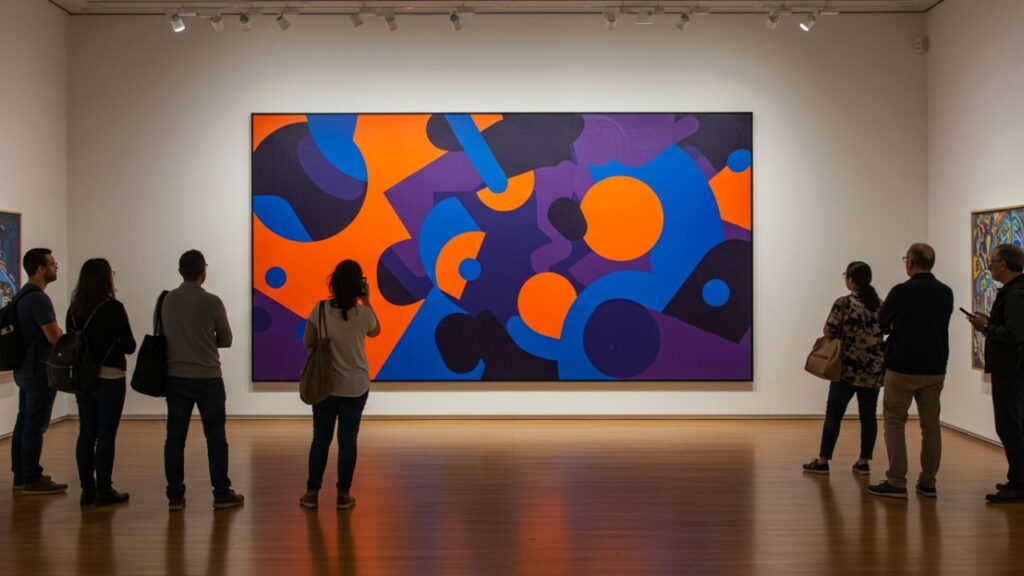Art is more than visuals—it’s a statement. The Quartist movement, a relatively modern yet growing trend, is changing how we perceive abstraction. Rooted in innovative visual languages, Quartist art blends expressive freedom with calculated geometric structure. It sits somewhere between traditional abstraction and algorithmic design, reflecting the complexities of our time.
Introduction to the Quartist Movement
The term Quartist emerges from the fusion of “Quartet” and “Artist,” implying harmony, complexity, and a multi-dimensional perspective in creation. While not yet a mainstream label in global galleries, this term has surfaced in niche art communities. It defines a rising generation of artists who are blending digital, geometric, and abstract motifs with a clear conceptual backbone.
At its core, Quartist art is about balance—between chaos and control, color and silence, form and interpretation. These works often reflect themes of identity, technology, and emotional depth. Unlike traditional abstract art that prioritizes randomness, the Quartist approach leans into structure without losing creative instinct.
Origins and Influences of Quartist Art
Though still developing as a distinct category, Quartist art draws from several 20th and 21st-century art styles. It owes debts to:
-
Constructivism for its structural aesthetic
-
Cubism for its spatial fragmentation
-
Minimalism for its disciplined approach
-
Digital art for its coded, often algorithmic nature
Early Quartist-inspired works appeared in experimental design schools and underground galleries in Berlin, Tokyo, and São Paulo around the early 2010s. Artists began blending mathematical algorithms with spontaneous brushwork, using both physical and digital mediums. What began as experimentation has now formed a coherent visual language.
Key Characteristics of Quartist Artwork
While diverse, Quartist creations tend to share a few core features:
-
Geometric repetition: Recurring patterns and modularity
-
Monochromatic or controlled color schemes
-
Hybrid media: Merging traditional paint with digital tools
-
Symbolic layering: Combining visual and conceptual depth
-
Intentional asymmetry: A design that looks off-balance but feels whole
Artists in this space often produce pieces that feel both mechanical and emotional—like an engineer’s interpretation of poetry.
Quartist in Digital and NFT Art
The digital revolution breathed new life into modern art, and Quartist artists were among the earliest adopters of the NFT wave. Their algorithmic and digital-first approach lends itself naturally to blockchain platforms. With smart contracts, these artists can embed interactivity and code directly into their art.
On platforms like Foundation, SuperRare, and KnownOrigin, Quartist pieces have been sold for high sums, attracting both collectors and technophiles. Their layered symbolism and tech-savvy appeal create demand across digital markets.
Leading Quartist Artists in 2025
While still an emerging genre, some artists are gaining recognition as pioneers:
-
Anna Riis – Her works blend data visualization with acrylic abstraction
-
Leo Kaume – Known for generative Quartist sculptures in virtual spaces
-
Renata Zhou – Combines Eastern philosophical symbols with geometric precision
-
Max Lorne – Pioneers interactive Quartist NFTs
Their pieces are not only exhibited in galleries but also embedded in AR/VR installations, allowing viewers to walk through and manipulate the art itself.
How Quartist Affects Modern Art Dialogue
In a world obsessed with clarity and explanation, Quartist art invites ambiguity. But this ambiguity isn’t chaotic—it’s intentional. It challenges the viewer to interpret, not consume.
Critics note how Quartist art bridges the gap between classical abstraction and modern AI aesthetics. In galleries and academic panels, it’s becoming a point of discussion for how art should evolve in the age of computation and climate change.
Quartist Themes: From Technology to Trauma
Many Quartist works touch on contemporary issues such as:
-
Digital overload
-
Data privacy
-
Urban isolation
-
Climate anxiety
-
Cultural fragmentation
Rather than depicting these ideas literally, Quartist artists use layered symbols, coded shapes, and interactive visuals. The goal? To provoke thought without dictating meaning.
Why Collectors Love Quartist Art
Collectors, especially younger Gen Z and millennial buyers, are drawn to the Quartist aesthetic because:
-
It aligns with tech-savvy lifestyles
-
It bridges analog beauty with digital innovation
-
It often includes interactive or evolving elements
-
It stands apart from traditional decorative art
With many quartet works being one-of-a-kind code-based creations, their value can rise significantly depending on the artist’s influence and execution.
How to Identify Quartist Works
Spotting a true quartetpiece involves checking for:
-
Mathematical composition
-
Symmetry with subtle disruption
-
Use of symbols or code-like markings
-
Digital traces like QR codes, motion elements, or embedded interactivity
-
Conceptual themes grounded in modern issues
Techniques Used by Quartist Creators
Some popular techniques include:
-
Generative art algorithms
-
Layered acrylics over 3D prints
-
Motion-based projection mapping
-
Augmented Reality (AR) overlays
-
Symbolic coding or data embedding
These methods aren’t used just for effect—they’re integral to the meaning and experience of each piece.
Quartet Art in Public Spaces
More cities are embracing quartet murals, installations, and interactive exhibits. From Berlin subway projections to LED-lit sculptures in Singapore, quartet public art is transforming urban landscapes. It’s not just art—it’s part of the city’s data, movement, and light.
Learning and Creating Quartet Art
Artists looking to explore this style often start with:
-
Courses in generative art
-
Workshops in symbolic abstraction
-
Digital art software like Processing, TouchDesigner, or Blender
-
Mixed media experimentation
Online platforms like Domestika, Skillshare, and MIT’s open courses are great places to start.
Quartet and the Future of Education
Some art schools are incorporating quartet techniques into their digital art curricula. The emphasis on hybrid thinking—logical structure plus creativity—makes it an ideal medium for 21st-century learning.
Art teachers are using quartet styles to teach students about:
-
Pattern recognition
-
Digital tools
-
Emotional intelligence through abstraction
Quartist and Social Commentary
Because it’s rooted in both control and chaos, the Quartist style naturally lends itself to socio-political themes. Artists are using it to comment on:
-
Surveillance capitalism
-
Data ownership
-
Identity fluidity
-
Migration and borders
-
Global connectivity and alienation
The use of symbols allows messages to reach across language barriers.
Where to View and Buy Quartist Art
Collectors and fans can explore quartet creations in:
-
Online galleries (e.g., SuperRare, ArtBlocks)
-
Instagram-based virtual galleries
-
Experimental exhibitions like Ars Electronica
-
Curated shows in postmodern spaces like The Hole NYC, NBB Gallery Berlin, or UCCA Beijing
Quartet as a Lifestyle Expression
Much like how Minimalism became a design and lifestyle ethos, quartet is extending beyond canvas. We’re seeing it in:
-
Architecture: Modular, data-responsive buildings
-
Fashion: Monochrome, patterned wearables
-
Tech products: Interfaces with Quartist-inspired UX
It’s becoming more than art—it’s a philosophy of living with harmony in a chaotic world.
Quartist in 2025: What’s Next?
As AI, AR, and mixed reality mature, so will quartet expressions. Expect to see:
-
Voice-reactive installations
-
Wearable art that changes with environment
-
AI-human collaboration pieces
-
Emotional feedback loops in art via biosensors
The boundaries are limitless—what matters most is intention.
Conclusion
The Quartist movement is not just a passing phase—it’s a mirror of our era’s complex harmony. It resonates with those navigating a fast-changing world, craving structure and meaning in chaos. Whether you’re a collector, a critic, or a curious onlooker, the quartet aesthetic promises to challenge your senses and shift your perceptions.







